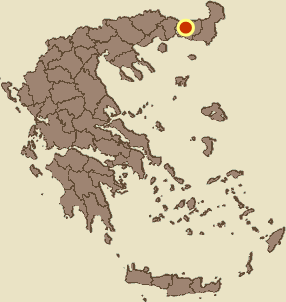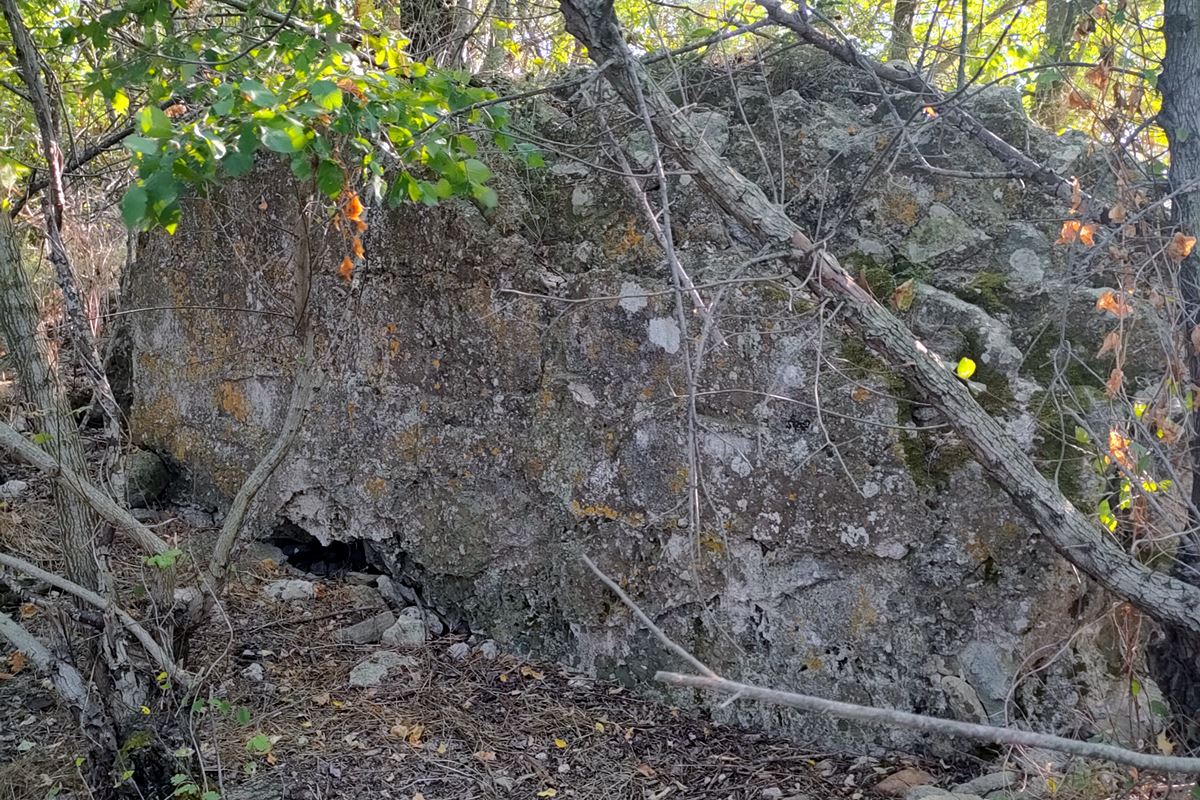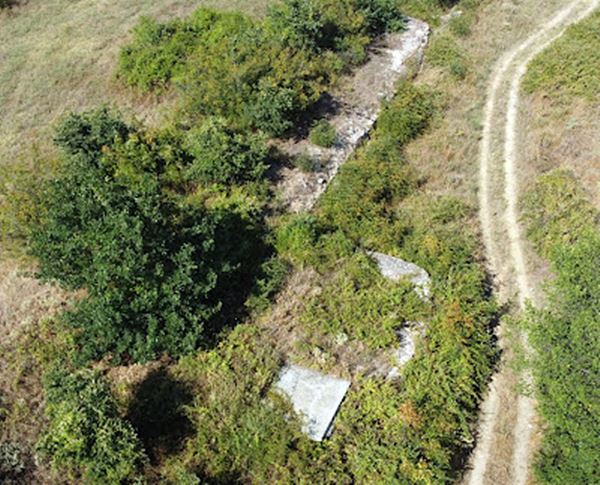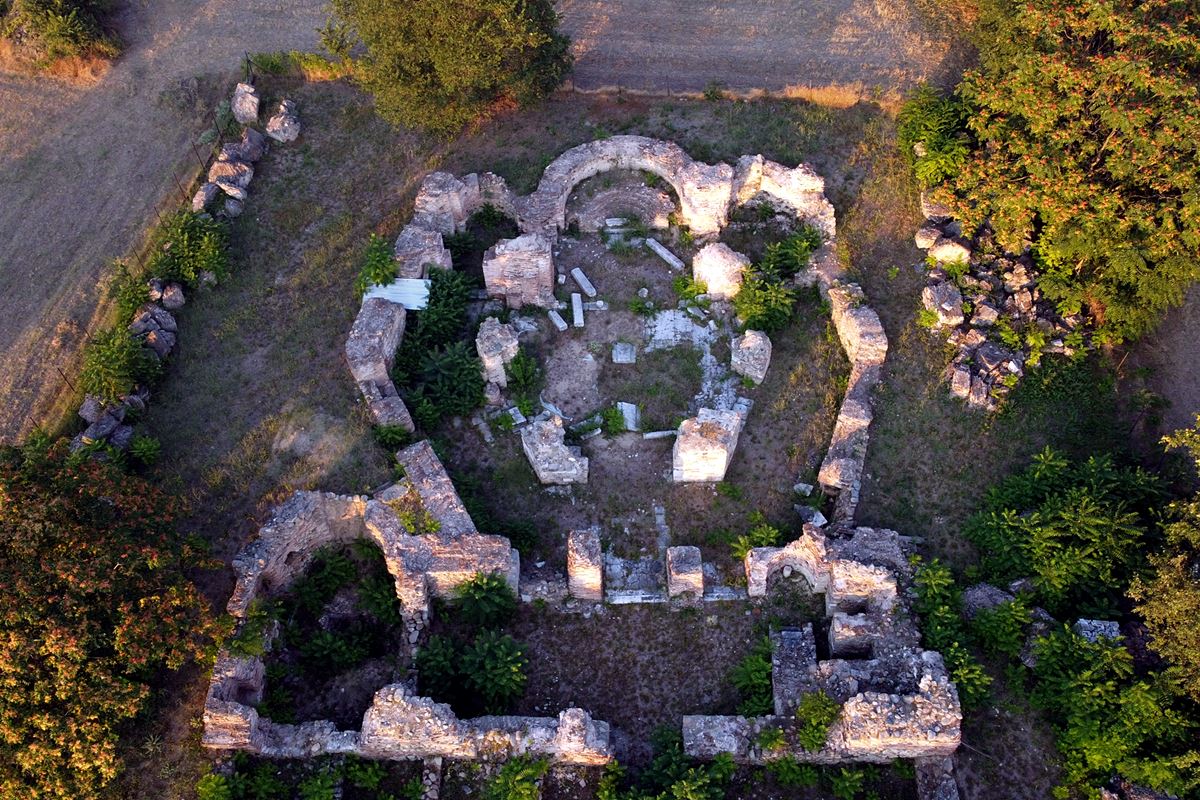Komotini, Komotini, Rhodope,East Macedonia & Thrace
Mosynopolis
| Location: |
| In a flat rural area, 6 kilometers west of Komotini, in Thrace, Northern Greece |
| Region > Prefecture: |  |
| East Macedonia & Thrace Rhodope | |
| Municipality > Town: | |
| City of Komotini • Komotini | |
| Altitude: | |
|
Elevation ≈ 45 m (Relative Height≈0 m) |
| Time of Construction | Origin | |
| Various periods | BYZANTINE |
|
| Castle Type | Condition | |
| Byzantine City |
Few Remains
|
Few remains from the fortification of Mosynopolis, a large and important Byzantine city in Thrace.
From the interior of the city, the only thing that survives is an excavated Byzantine church, while few ruins remain of the walls, at a low height, which are largely hidden by vegetation.
But the outline of the fortification is clear in the satellite image (see also the layout).
The Name of the Castle
The city was called “Maximianoupolis” during the early Byzantine period and “Mosynopolis” during the Middle Byzantine period.
Maximianoupolis is mentioned for the first time by the historian Ammianus Marcellinus (332–395 AD). Probably, the name is due to the Roman emperor Galerius who was Augustus of the East from 305 to 311 and whose full name was Gaius Galerius Valerius Maximianus.
At the end of the 9th century the name Mosynopolis appears.
The Frankish crusader and historian Geoffroi de Villehardouin (uncle of the namesake prince of Achaia) names the city Messinople. Ioannis Kantakouzinos, in his work “Historiai”, where he recounts the events of the period 1320-1356, calls it “Messini” for some reason (in 7 references).
"Mosynopolis" probably comes from the ancient word μοσσυν, (which is found in Xenophon and means a wooden house or tower). Perhaps at some time, there, in the 9th century when the city was being rebuilt, temporary (?) wooden walls and towers were built. Another less likely etymology is from the word “μεση” meaning “middle” (being in the middle of the plain or approximately in the middle of the Thessaloniki-Constantinople route) which produced Mesinopolis which was perhaps corrupted into Mosinopolis by the neighboring Slavs, Bulgarians, etc. This would explain the late Byzantine simplification to “Messini”.
Structure, Fortification & Buildings
The outline of the fortification is almost a rectangle, with the long side on the SW-NE axis (see also the layout).The length of the perimeter of the fortification is over 2.5 km. The west side was 460 meters, the north 850, the east 435 and the south 800 meters. The area enclosed by the walls is 382,000 sq.m. Without a doubt, Mosinopolis was a really big city by the standards of the Middle Ages. It must have been the third largest city in the Balkans after Constantinople and Thessaloniki!
The fortification had circular towers in the corners and rectangular ones in the sides at regular intervals, every 50m. So the towers must have been over 50! The design of the fortification follows the standards of a classic – but enlarged – Roman quadriburgium.
From this mighty fortification, only a few parts of the wall survive today. Of the 50 plus towers, 3 towers can be seen today at a low height: a circular one (photos 4,5) in the southeast corner and two quadrangular ones next to it. All three at a low height – 1.5 to 2 meters. There are probably others hidden by the vegetation.
Most of the walls do not exceed the height of the foundations. The few sections that are at a higher height are difficult to distinguish due to the uncontrolled vegetation. It should be noted that the vegetation is dense only along the wall, while the rest of the area within the walls is covered by cultivated fields. The fact that the vegetation is dense only on the edge is what reveals the trace of the wall.
The thickness of the wall was about 2.5 m. The maximum height detected is on the north side and reaches up to 2.5-3 meters.
The masonry consists of clay stones, and white binding mortar. In most of the surviving sections, binding zones with bricks are visible, a common feature of Byzantine fortifications.
Mosynopolis was excavated in the years 1975/76 by Charalambos Pennas, and then part of the western fortification was discovered (photo 7). Since then, no other serious attempt has been made, for the fortification, and the site has been neglected.
Excavation research of the last years revealed inside the city a large pericentric temple of the 11th-12th century, which is believed to have been the city's episcopal church. The area around the temple is the only one that is fenced and is not accessible to the visitor.
Outside the northern wall, there are fragments of walls and some arched sections that form an almost straight wall 70 meters long that ends in the bed of the Aspropotamos river. This outer structure is joined perpendicularly to the north wall at a point 150 meters from the NE corner.This was probably an aqueduct.
| First entry in Kastrologos: | September 2022 |
Sources
- Έρευνα, φωτογραφίες και πληροφορίες από τον Σάκη Αμφιτρείδη και το blog του ΑΜΦΙΤΡΕΙΔΗΣ (2022)
- Website ΟΔΥΣΣΕΥΣ - Greek ministry of Culture, Μαξιμιανούπολις-Μοσυνούπολις, author: Νικόλαος Ζήκος
- Κωνσταντίνα Ευκλείδου, «Η βυζαντινή Μοσυνόπολη. Από τη Μαξιμιανούπολη στη Μεσήνη (4ος-14ος αι.)», Στο: Σέργης, Μ. και συνεργάτες (Επιστημονική Επιτροπή), Όψεις της Ιστορίας και του Πολιτισμού της Θράκης. Κομοτηνή: Σχολή Κλασικών και Ανθρωπιστικών Σπουδών Δ.Π.Θ., Περιφερειακή Διεύθυνση Π/θμιας και Δ/θμιας Εκπαίδευσης Αν. Μακεδονίας και Θράκης, Κομοτηνή 2015, σελ.61-93.
- ΑΡΧΑΙΟΛΟΓΙΚΟΝ ΔΕΛΤΙΟΝ, τεύχος 30/Β2 (1975), σελ. 311-312
|
|
| Access |
|---|
| Approach to the monument: |
| We start from Komotini towards Iasmos from the old country road. After 6 km we see a brown road sign “Maximianoupolis”. We turn right onto an asphalt road for 1km and after a short dirt road we are in the area of the ruins. |
| Entrance: |
| Free access. The area around the basilica is fenced and locked. |
| Other castles around |
|---|
| Fortress of Gratini |
| Komotini Walls |
| Castle of Linos |
| Tower of Molyvoti |
| Fortress of Nymfea |
| Castle of Polyantho |
| Castle of Poroi |
| Castle of Thamna |








